
Fish-Attracting Sound & Vibration
Figure out the right combination to catch plenty of fish this spring.
Story and Photography by Danno Wise
I remember as a kid in the 70s seeing foam trays filled with popping corks – already a staple of Texas trout fishermen at that time. Back then, your options were limited to length and whether the drab green conical, cup-faced model was weighted or unweighted (I preferred weighted). Some years later, a few bright yellow (or chartreuse) models made their way onto the shelves. Shortly after that, a tiny round rattle bead appeared in the face of a few popping corks. The bead didn’t produce much sound. But, if you shook the cork vigorously (and there was no wind and no one was talking), you could hear the faint click emitted from the cork. “Rattling Corks” had made their appearance on the Texas coast.
Over the decades since, the simple popping cork has evolved, to say the least. Popping corks are now available in a variety of sizes, shapes, and noise producing capabilities. Some modern rattling corks has a soft cadence while others sound more akin to a Mexican maraca than something you would fish with. However, each of these incarnations of the modest popping cork have the same purpose – as do dozens of hard and soft-plastic artificial lures – to produce just the right amount of sound to attract fish.
Given the often strong winds of spring, more often than not coastal bays experience choppy waters. Any surface disturbance causes noise and, quite often, results in lower visibility. Each of these conditions makes it more difficult for fish to locate baits and lures. As a result, fishermen often resort to sound in order to aid the fish in finding their baits.
However, figuring out the right noise combination can be a little trickier than it sounds. When using noise-producing lures or accessories, anglers have to be careful. After all the goal is to alert, not alarm, nearby fish. Anglers must choose lures, corks, rattles and other noise producing items based on the prevailing conditions. If too little noise or vibration is produced for the given conditions, the lure or bait may simply go unnoticed. If too much noise is produced, any nearby fish will likely be spooked. In order to select the proper level of sound in various conditions, fishermen must first have a good understanding for how various lures and accessories emit sound and how water and wind can affect the amount of noise necessary to attract fish.








